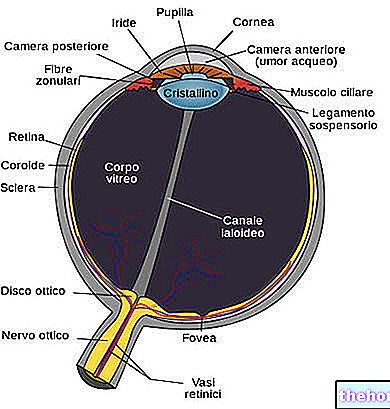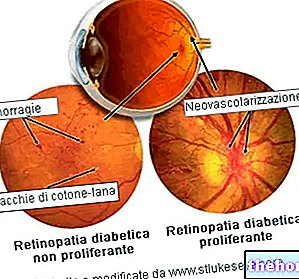Amblyopia or lazy eye is an ocular discomfort. Characterized by a weakening of the vision of one of the two eyes, it frequently occurs in children.

Amblyopia can be idiopathic or occur in the case of:
- Strabismus.
- Different quality of vision between the eyes due to refractive errors.
- Less common causes (cataract, corneal ulcer or scar, glaucoma, drooping eyelid and hemangioma.
The lazy eye manifests itself with:
- Difficulty in vision.
- Involuntary eye movements.
- Reduced sensitivity to contrast and movement.
- Poor depth perception.
The material published is intended to allow quick access to advice, suggestions and general remedies that doctors and textbooks usually dispense for the treatment of Lazy Eye; these indications must in no way replace the opinion of the treating physician. or other healthcare specialists in the sector who are treating the patient.
What to do
Amblyopia is a condition that sometimes requires the help of glasses or contact lenses. However, these cannot be prescribed without a well-defined diagnosis.
This means that, in the doubt of a lazy eye, it is necessary:
- Make an early diagnosis. In children it is good to have a vision check-up already at the age of 3-5 years.
- Pay more attention if there are cases of amblyopia in the family (from strabismus, infantile cataracts, etc.) and schedule checks every 2 years.
- Make the correction:
- Constant use of glasses or contact lenses.
- Restoration of the weak eye. This is "forced" to develop by limitation of the strong one; for example:
- Covering it with a bandage.
- Giving a few drops of eye drops.
- Alternatively, treatment can include:
- Corrective lenses.
- Surgery.
What NOT to do
- Do the first eye check-up at an advanced age, beyond 7 years of life.
- This is even more wrong in the case of inheritance or in the doubt that the child may have vision problems.
- After diagnosis:
- Do not use glasses or contact lenses.
- Do not practice the visual exercises with the blindfold.
- Do not comply with drug therapy.
What to eat
There are no foods directly implicated in the onset, aggravation or cure of the lazy eye.
However, there are nutrients that are essential for ocular development and maintenance, including:
- Vitamin C or ascorbic acid: contained mainly in acidic fruit (citrus fruits, kiwis, etc.) and in some vegetables (lettuce, peppers, parsley, etc.), it fights free radicals and optimizes the cellular function of the optic nerve.
- Vitamin A: in the form of carotenoids and retinol it is contained in milk, cheese, liver, crustaceans, fruit and vegetables of orange and red color (peppers, carrots, tomatoes, apricots, peaches, melon, etc.). It is involved in the protection of eyesight (especially in the lutein and zeaxanthin forms).
- Vitamin E: powerful antioxidant contained in the germ of cereals, in some oily legumes, in other fatty seeds and in the relative extraction oils.
- Omega 3 essential fatty acids: fundamental against systemic inflammation, they have countless functions, including the support of sight. They are contained in oily oily fish (sardines, mackerel, bonito, alletterate, etc.), in algae, in some oil seeds (kiwi, flax, etc.) and related oils.
What NOT to Eat
There is no list of foods to avoid to improve lazy eye.
We only remember that foods harmful to the metabolism are contraindicated:
- Rich in saturated fats (fatty cheeses, fast food, etc.).
- Rich in hydrogenated fats (packaged baked goods, sweet and savory snacks).
- Rich in nitrates (preserved foods such as cured meats, etc.).
- With very high glycemic load and index, in case of diabetes mellitus. Hyperglycemia can only worsen cataracts. On the other hand, remember that infantile cataracts are congenital but in the case of comorbid diabetes it is strictly necessary to avoid hyperglycemia.
- Very salty: they can aggravate hypertension, a disease harmful to the eyes. Except for the most severe hereditary forms, this disease should mainly affect adults. However, childhood obesity has also increased the risk of metabolic syndrome in children.
Natural Cures and Remedies
Among the natural remedies for amblyopia we should first of all mention the therapy of the bandage. On the other hand, it will be described in the chapter of “Medical Treatments”.
In the past, the Celtic world used to treat lazy eye with a topical natural remedy called Hygra.
There is no scientific basis to prove what the ancient Celtic population supposed and, if you want to prove it, it is recommended to consult your doctor:
- Hygra: 2 ounces of saffron, one "ounce of white pepper, 1 gram of saltpetre, one" ounce of myrrh and one gram of Attica honey. Apply a few drops on the lazy eye and wait for tearing.
Pharmacological treatment
The only drug used as a remedy for amblyopia is atropine.
It is not a molecule capable of improving the visual deficit of the underdeveloped eye, but an active ingredient that temporarily reduces the efficiency of the healthy one:
- Atropine in eye drops: one drop twice a week or every day temporarily reduces the visual capacity of the dominant eye. It serves to indirectly stimulate the ability of the lazy eye, helping the development of the portion of the brain responsible for processing vision. It can rarely have side effects such as:
- Eye irritation.
- Redness of the skin.
- Headache.
It is less effective in cases of myopia.
Prevention
It is not possible to prevent amblyopia but it is necessary to intervene early (screening) so that it does not worsen or become chronic.
The only advisable system is an early check-up and, in the case of a therapy, the scheduling of fairly close checks.
Medical treatments
To treat amblyopia it is advisable to reduce the efficiency of the healthy eye to stimulate the brain to perfect the vision of the weak eye. In addition to drugs, this can be achieved with patching:
- Also called “blindfold therapy”, it is based on the placement of an opaque and adhesive patch on the skin of the dominant eye. In this way the subject is forced to reinforce the use of the lazy one. Treatment must be continued in proportion to the severity of the amblyopia. Usually 3-6 hours a day for a few weeks or a few months is enough. Certain activities such as reading, coloring, drawing etc. can speed up the process. It is advisable to schedule routine checks during treatment. The effectiveness of therapy is greater if implemented before 7-8 years of age.
Alternatively, surgery can be used:
- Also called Lasik (Intrastomal Laser Keratomileusis), laser surgery is based on restoring the "visual balance between the two eyes. It is more suitable for adults; in children it is used only when other treatments have failed.
- Another type of surgery is the removal of the clouded lens from congenital cataracts and replacement with a synthetic lens. Remember that not all cases of cataracts require surgery.




























